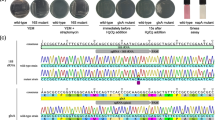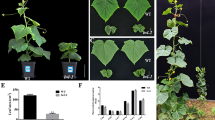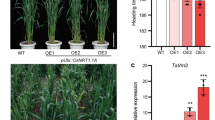Abstract
Glyphosate, a functional analogue of phosphoenolpyruvate (PEP), blocks the shikimate pathway by inhibiting the enzyme 5-enolpyruvylshikimate-3-phosphate synthase (EPSPS; EC 2.5.1.19) through interference with the conversion of (shikimate-3-phosphate) S3P and PEP to 5-enolpyruvylshikimate-3-phosphate (EPSP) and subsequently leads to plant death. This metabolic pathway possesses great potential to be used for development of herbicide resistant transgenic crops and here in this study, we wanted to check the expression potential of CP4-EPSPS gene in various sugarcane genotypes. A synthetic version of CP4-EPSPS gene synthesized commercially, cloned in pGreen0029 vector, was transformed into regenerable embryogenic calli of three different sugarcane cultivars HSF-240, S2003US-778 and S2003US-114 using biolistic gene transfer approach for comparative transcriptional studies. Transgenic lines screened by PCR analysis were subjected to Southern hybridization for checking transgene integration patterns. All the tested lines were found to contain multiple (3–6) insert copies. Putative transgenic plants produced the CP4-EPSPS protein which was detected using immunoblot analysis. The CP4-EPSPS transcript expression detected by qRT-PCR was found to vary from genotype to genotype and is being reported first time. In vitro glyphosate assay showed that transformed plants were conferring herbicide tolerance. It is concluded that different cultivars of sugarcane give variable expression of the same transgene and reasons for this phenomenon needs to be investigated.






Similar content being viewed by others
References
Adamczyk J Jr, Meredith W Jr (2004) 1260501. Genetic basis for variability of Cry1Ac expression among commercial transgenic Bacillus thuringiensis (Bt) cotton cultivars in the United States. J Cotton Sci 8:433–440
Adamczyk JJ, Sumerford DV (2001) Potential factors impacting season-long expression of Cry1Ac in 13 commercial varieties of Bollgard® cotton. J Insect Sci 1(13):1–6
Altpeter F, Baisakh N, Beachy R, Bock R, Capell T, Christou P, Daniell H, Datta K, Datta S, Dix PJ (2005) Particle bombardment and the genetic enhancement of crops: myths and realities. Mol Breeding 15:305–327
Bower R, Elliott AR, Potier BA, Birch RG (1996) High-efficiency, microprojectile-mediated cotransformation of sugarcane, using visible or selectable markers. Mol Breeding 2:239–249
Butterfield M, D’hont A, Berding N (2001) The sugarcane genome: a synthesis of current understanding, and lessons for breeding and biotechnology. In: Proc S Afr Sug Technol Ass. Citeseer, pp 1–5
Cao G, Liu Y, Zhang S, Yang X, Chen R, Zhang Y, Lu W, Liu Y, Wang J, Lin M (2012) A novel 5-enolpyruvylshikimate-3-phosphate synthase shows high glyphosate tolerance in Escherichia coli and tobacco plants. PLoS ONE 7:e38718
Chou T-C, Moyle RL (2014) Synthetic versions of firefly luciferase and Renilla luciferase reporter genes that resist transgene silencing in sugarcane. BMC Plant Biol 14:92
Dill GM (2005) Glyphosate-resistant crops: history, status and future. Pest Manag Sci 61:219–224
Dong H, Li W (2007) Variability of endotoxin expression in Bt transgenic cotton. J Agron Crop Sci 193:21–29
Finn TE, Wang L, Smolilo D, Smith NA, White R, Chaudhury A (2011) Transgene expression and transgene-induced silencing in diploid and autotetraploid Arabidopsis. Genetics 187:409–423
Finnegan E, Llewellyn D, Fitt G (1998) What’s happening to the expression of the insect protection in field-grown Ingard® cotton. In: The ninth Australian cotton conference proceedings, pp 291–297
Fu H, Dooner HK (2002) Intraspecific violation of genetic colinearity and its implications in maize. Proc Natl Acad Sci USA 99:9573–9578
Gustafsson C, Govindarajan S, Minshull J (2004) Codon bias and heterologous protein expression. Trends Biotechnol 22:346–353
Jackson MA, Anderson DJ, Birch RG (2013) Comparison of Agrobacterium and particle bombardment using whole plasmid or minimal cassette for production of high-expressing, low-copy transgenic plants. Transgenic Res 22:143–151
Jiang N, Bao Z, Zhang X, Eddy SR, Wessler SR (2004) Pack-MULE transposable elements mediate gene evolution in plants. Nature 431:569–573
Kinkema M, Geijskes J, Palupe A, Shand K, Coleman HD, Brinin A, Williams B, Sainz M, Dale JL (2014) Improved molecular tools for sugar cane biotechnology. Plant Mol Biol 84:497–508
Lai J, Ma J, Swigoňová Z, Ramakrishna W, Linton E, Llaca V, Tanyolac B, Park Y-J, Jeong O-Y, Bennetzen JL (2004) Gene loss and movement in the maize genome. Genome Res 14:1924–1931
Noguera A, Enrique R, Perera MF, Ostengo S, Racedo J, Costilla D, Zossi S, Cuenya MI, Filippone MP, Welin B (2015) Genetic characterization and field evaluation to recover parental phenotype in transgenic sugarcane: a step toward commercial release. Mol Breeding 35:1–15
Pettigrew W, Adamczyk J (2006) Nitrogen fertility and planting date effects on lint yield and Cry1Ac (Bt) endotoxin production. Agron J 98:691–697
Pollegioni L, Schonbrunn E, Siehl D (2011) Molecular basis of glyphosate resistance: different approaches through protein engineering. FEBS J 278:2753–2766
Sachs E, Benedict J, Stelly D, Taylor J, Altman D, Berberich S (1998) Expression and segregation of genes encoding CryIA insecticidal proteins in cotton. Crop Sci 38:1–11
Tzin V, Galili G (2010) The biosynthetic pathways for shikimate and aromatic amino acids in Arabidopsis thaliana. Arabidopsis Book 8:e0132
Vickers J, Grof C, Bonnett G, Jackson P, Morgan T (2005) Effects of tissue culture, biolistic transformation, and introduction of PPO and SPS gene constructs on performance of sugarcane clones in the field. Crop Pasture Sci 56:57–68
Welch M, Villalobos A, Gustafsson C, Minshull J (2011) 3 Designing genes for successful protein expression. Method Enzymol 498:43
Wessler SR (2001) Plant transposable elements. A hard act to follow. Plant Physiol 125:149–151
Author information
Authors and Affiliations
Corresponding author
Additional information
Publisher's Note
Springer Nature remains neutral with regard to jurisdictional claims in published maps and institutional affiliations.
Rights and permissions
About this article
Cite this article
Imran, M., Barboza, A.L., Asad, S. et al. Expression patterns of cp4-epsps gene in diverse transgenic Saccharum officinarum L. genotypes. Physiol Mol Biol Plants 25, 779–786 (2019). https://doi.org/10.1007/s12298-019-00650-y
Received:
Revised:
Accepted:
Published:
Issue Date:
DOI: https://doi.org/10.1007/s12298-019-00650-y




